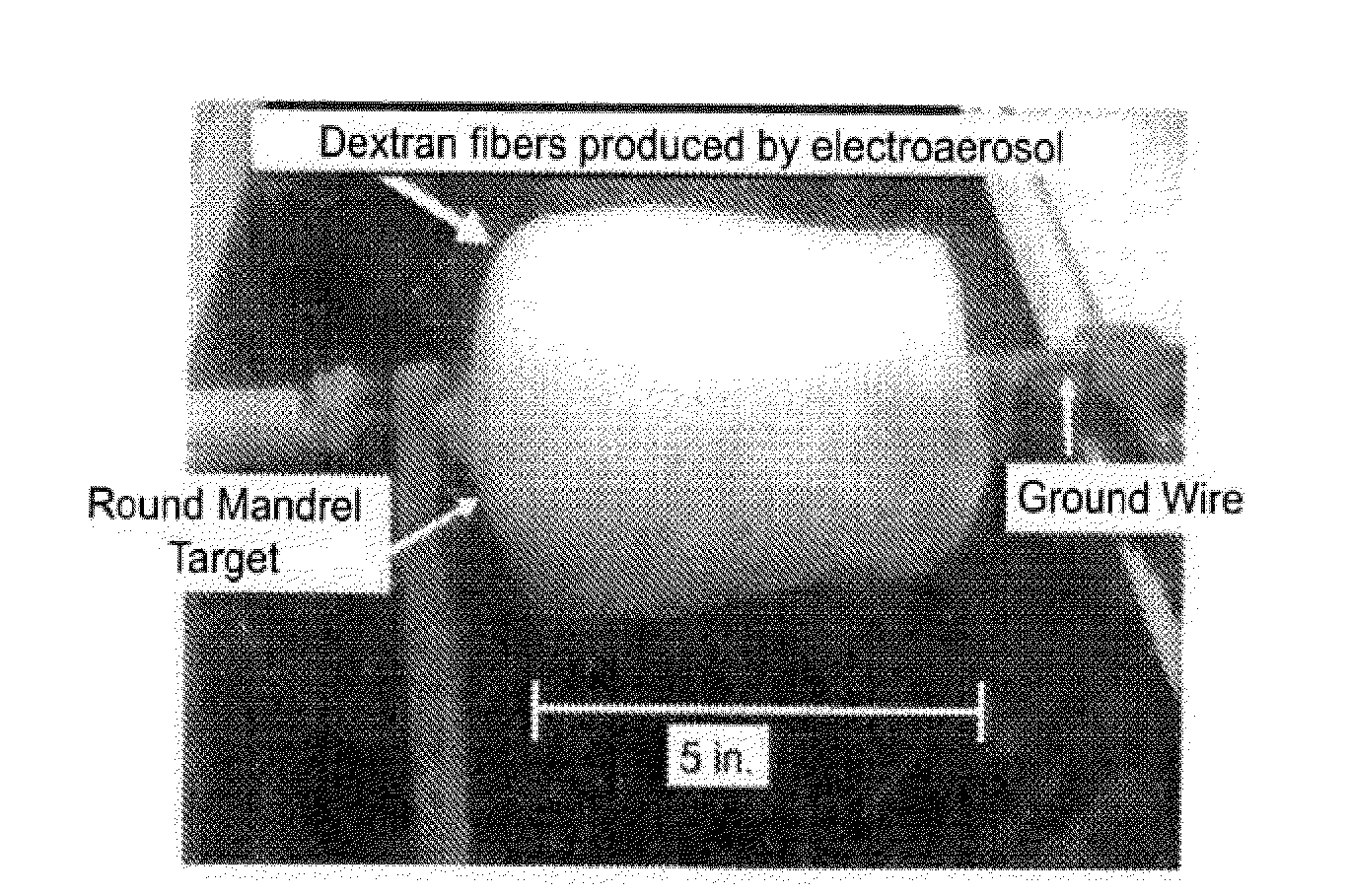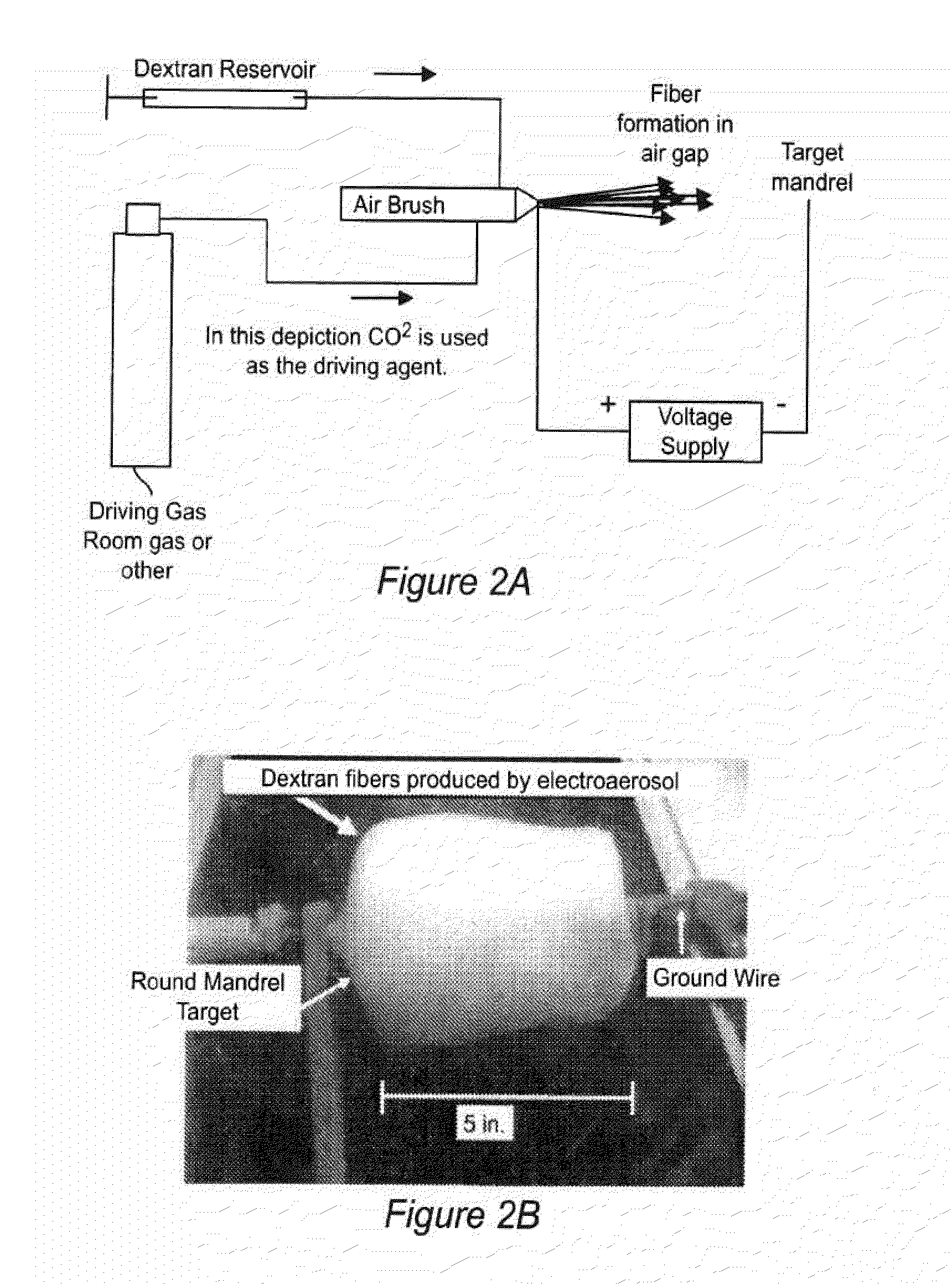Electrospun dextran fibers and devices formed therefrom
- Summary
- Abstract
- Description
- Claims
- Application Information
AI Technical Summary
Benefits of technology
Problems solved by technology
Method used
Image
Examples
example 1
Bandage Fabrication
[0064]Approximately 5 g of dextran (100,000-200,000 Mr) was used to produce a bandage that has a total weight of about 7 g after the addition of 2 gms of particulate fibrinogen. Approximately 5 g of dextran was suspended in distilled water at a concentration of 1.0 gm / ml. This solution was incubated overnight on a clinical rotator set to rotate 1-5 rotations per minute. These conditions were used to insure that the dextran is completely in solution. The dextran solution was loaded into a syringe capped with a blunt tipped needle, and approximately 5 mls per bandage was used in the fabrication process. For electrospinning, the syringe was mounted into a syringe driver calibrated to deliver 3-5 mls / hour to the electric field. The syringe driver is used to meter the delivery of material to the electric field and this setting does not necessarily accurately reflect the rate of fabrication as the electric field draws the dextran from the syringe.
[0065]Salmon fibrinogen...
example 2
Scaling of Electrospinning for Manufacturing
[0069]Electrospinning is a method of producing a fibrous matrix composed of small diameter, nano-to-micron scale fibers. This process can be scaled for manufacturing by at least 3 different methods:
Multiple Jets. The use of multiple jets represents a simple solution to scaling the manufacturing process. As depicted in FIG. 1, it is possible to use multiple jets to increase the throughput of electrospinning. This can be done with dextran, however, the humidity level of the processing environment must be controlled; excess moisture limits the volume of material that can be collected and small drops of overspray can cause the dextran to dissolve. The level of humidity should be controlled to be from about 30% to about 40%, and typically at least about 20%. In one embodiment, multiple jets are arrayed above a conveyor belt. Each jet delivers a set amount of dextran, the process stops, the belt may move forward to allow a dose of e.g. fibrinoge...
example 3
Electrospun Dextran for Use as a Backing
[0070]PGA and PLA (2 synthetic, biocompatible polymers) are used to provide strength to the backing material. Fibrinogen is added to the PGA / PLA mixture and clearly represents a protein element of the composition. A 90:10 mixture of hexafluoroisopropanol (HFP) is added to aqueous (water, culture media, PBS, etc.) solvent saturated with calcium chloride (the calcium helps to promote the clotting cascade, or other salt) solution is prepared. The PGA / PLA polymers and fibrinogen are added to this solution and allowed to go into solution. Typical conditions are 100 mgs of PGA / PLA mixture (ranging from 99:1.0 PGA / PLA to 1.0:99 PGA / PLA ratio), 10-50 mgs fibrinogen per ml of electrospinning solution. Once in solution, the composition is electrospun to form a fibrous mat of material. The synthetic polymers provide strength; the fibrinogen component provides cross-linkable sites for active ingredients to interact with during clot formation. Ideally the ...
PUM
| Property | Measurement | Unit |
|---|---|---|
| Diameter | aaaaa | aaaaa |
| Diameter | aaaaa | aaaaa |
| Diameter | aaaaa | aaaaa |
Abstract
Description
Claims
Application Information
 Login to View More
Login to View More - R&D
- Intellectual Property
- Life Sciences
- Materials
- Tech Scout
- Unparalleled Data Quality
- Higher Quality Content
- 60% Fewer Hallucinations
Browse by: Latest US Patents, China's latest patents, Technical Efficacy Thesaurus, Application Domain, Technology Topic, Popular Technical Reports.
© 2025 PatSnap. All rights reserved.Legal|Privacy policy|Modern Slavery Act Transparency Statement|Sitemap|About US| Contact US: help@patsnap.com



